| Vintage Pulp | Apr 25 2020 |

No, it's not a Halloween costume, gringo. We don't have that here. We have Day of the Dead. Wanna find out how it works?

The Long Escape was originally published 1948, and was the first of a trio of books written by David Dodge starring his investigator character Al Colby. The cover art by Robert Stanley depicts a scene that actually occurs in the narrative, but the book is not a western style adventure. It's a missing person mystery that starts in California, passes through Mexico, Guatemala and Honduras, and finally settles in Chile. The man under the poncho is a sort of Chilean vaquero who loves horses and guns, and is a generally hostile guy. But Colby is not one to be easily bested. He may be a gringo, but he's fluent in Spanish, as well as the ways and means of Latin America. The Long Escape is a good book. Everything we've read by Dodge so far is good. In our opinion the second Colby outing, Plunder of the Sun, is even a bit better, but you can't go wrong with this particular author. We'll continue making our way through his catalog and report back.
| Vintage Pulp | Apr 10 2020 |

Troublesome Nazis bring bad intentions to Mexico City.

The much beloved Santo movies may not be good, but you certainly can't complain about the promo posters. This winner was made for Santo en Anónimo mortal, aka Santo in Anonymous Death Threat, and it finds everyone's favorite luchador once again battling the forces of evil. This time he's called upon to help the latest in a line of men who've been sent anonymous notes informing them of the dates of their deaths. The previous recipients met nasty ends. The newest prospective victim doesn't trust the police to keep him alive, so he appeals to the only man that can truly do the job—Santo el enmascarado de plata. Santo rightly wonders what the connection is between all these men. But viewers don't have to wonder—it's right there on the poster.
Yes, Nazis have made their sneaky way to Mexico. And just to ram the point home fully, Santo coincidentally has a match against a wrestler named El Nazi, who mid-round is shot dead, becoming yet another victim. Santo soon learns that all the departed—even El Nazi, who must have adopted his moniker due to a keen sense of irony—were witnesses at the war crimes trial of a Third Reich death merchant named Paul von Struber. This von Struber was sentenced to hang, but escaped to Mexico City, where he took an assumed identity. Now he wants revenge on everyone who testified against him because— Well, that's hard to figure out. He really should just lay low, having evaded the hangman. But he's a Nazi. They specialize in terrible ideas.
By the time this film appeared Santo had already battled vampires, zombies, and witches. The producers of these potboilers went big early. Overloaded with crazy concepts, they even had Santo go up against a carnivorous blob. Nazis, then, aren't that big a deal. Santo doesn't even have to cut his wrestling schedule short. When the evil von Struber captures him and locks him away in the secret Nazi lair, he quickly manages to break his ropes, beat the shit out of the flunkies guarding him, and bring down El Cuarto Reich before it even has a chance to stick its head out of its bunker. It's good that Santo's triumph is so perfunctory, because this was his forty-somethingth adventure and his knees had to be getting balky. Santo en Anónimo mortal premiered in Mexico today in 1975.
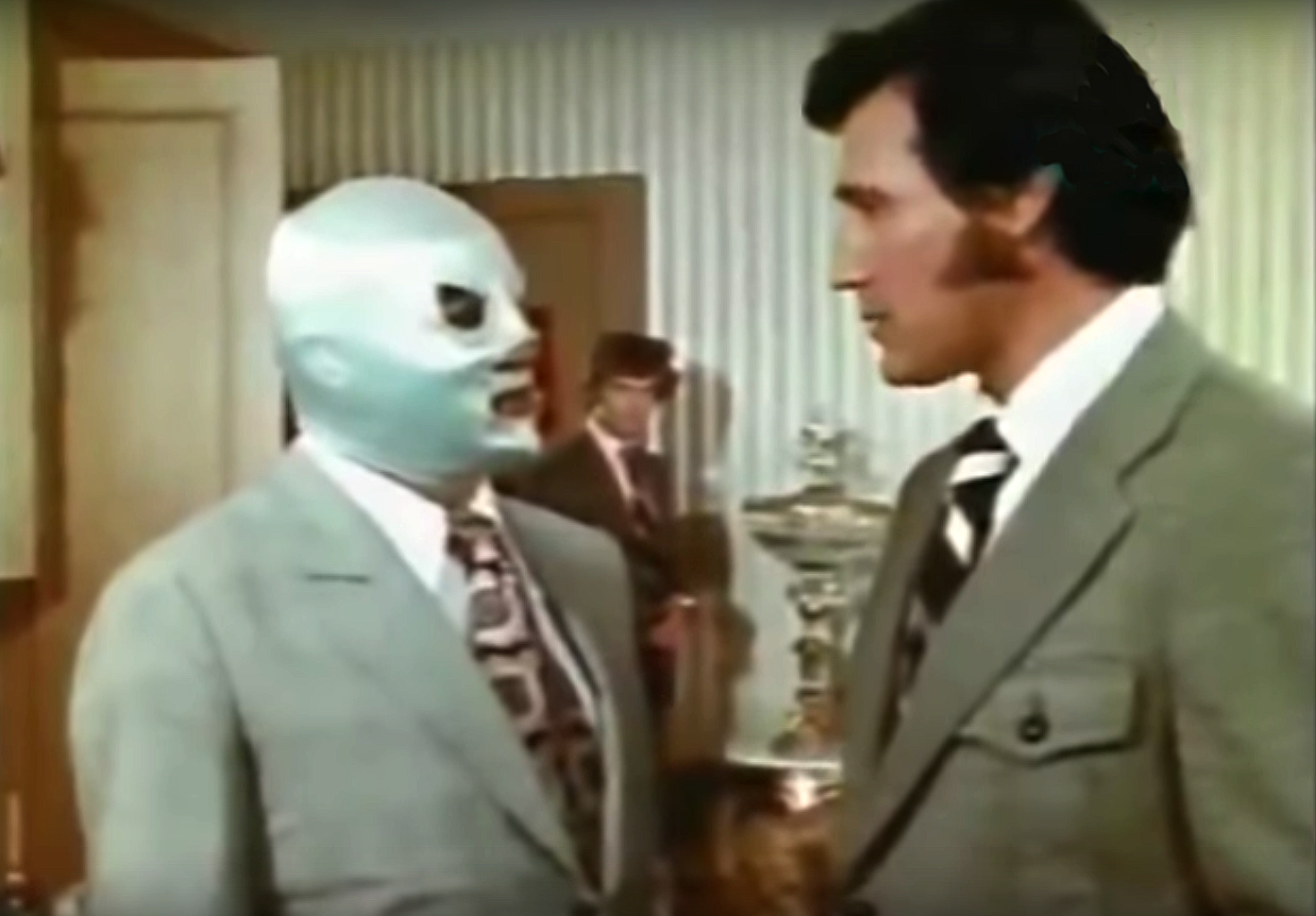 Wow, you're a big'un, aren't you? Ever considered pro wrestling? If you wanna meet up later I can teach you some submission holds.
Wow, you're a big'un, aren't you? Ever considered pro wrestling? If you wanna meet up later I can teach you some submission holds.
 Wow, you're a big'un, aren't you? Ever considered pro wrestling? If you wanna meet up later I can teach you some submission holds.
Wow, you're a big'un, aren't you? Ever considered pro wrestling? If you wanna meet up later I can teach you some submission holds. Obergruppenführer! I have a question!
Obergruppenführer! I have a question!| Vintage Pulp | Mar 28 2020 |

Acapulco's toughest crimefighter is throwing out the trash.
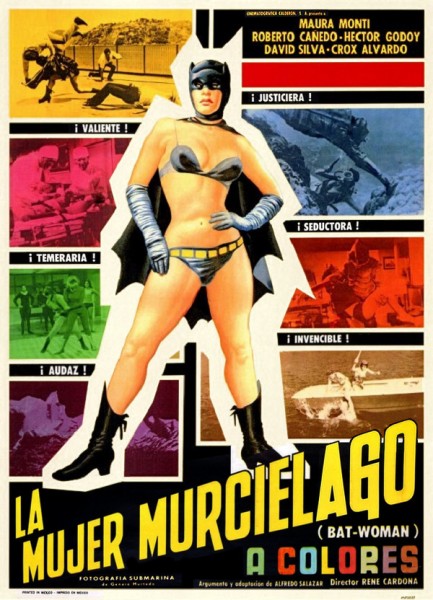
There's a new flying mammal in town, and her name is la Mujer Murciélago—the Bat Woman. Maybe that's more of a title than a name, but you get the idea. Who exactly is this caped crusader? Well, she's—and this is verbatim from the film—“a wonderful and very rich lady who lives in the capital city, and uses her vast fortune to fight against the forces of evil.” Generally rich people are the forces of evil, so we greatly respect her for going against type, but as a crimefighter she has a real headscratcher on her hands. Luchadores are being murdered and the juices of their pineal glands extracted. Clearly these are not crimes with an ordinary motive. Who'd want the brain juices of wrestlers? Gourmet cannibals? Cthulhu cultists?
Cut to the villain in his secret lair. He goes by the sinister name of Eric Williams, and he's stealing wrestler juice because athletes of that type are perfect physical specimens for his scheme to create a race of powerful fish men. We're not sure if we ever understood why he wants to create fish men, but whatever, Bat Woman pretty much immediately suspects this Eric guy, not least because he lives on Acapulco Bay in a big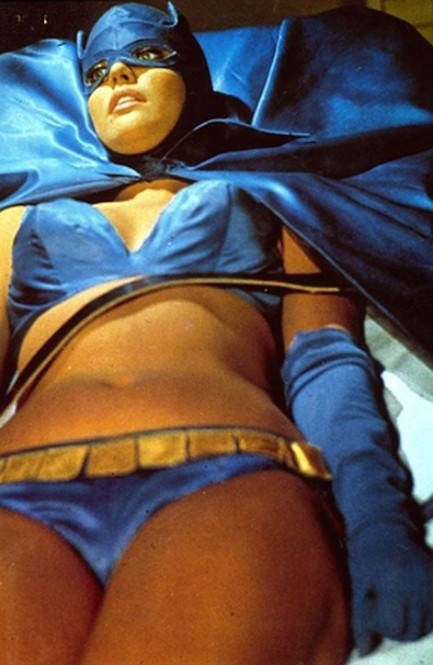 houseboat called Reptilicus—a name that's a strong indicator of villainy. He should have just gone all the way and called the boat My Evil Lair.
houseboat called Reptilicus—a name that's a strong indicator of villainy. He should have just gone all the way and called the boat My Evil Lair.
 houseboat called Reptilicus—a name that's a strong indicator of villainy. He should have just gone all the way and called the boat My Evil Lair.
houseboat called Reptilicus—a name that's a strong indicator of villainy. He should have just gone all the way and called the boat My Evil Lair.Does crazy doc Eric make a fish man? Hah. It'd hardly be worth watching the movie if he didn't. Cue guy in a lobster red costume with scuba fins for feet. Having fulfilled his ambition, doc Eric's plan is to now create another horrible hybrid—a fish woman. Guess who he wants captured for that project? But when you step up to Bat Woman you better bring your a-game, because she throws some killer curves.
We won't tell you more about the plot, but we will tell you this about the movie as a whole: it's a disaster. We could enumerate some of its merits, like its interesting shots of an Acapulco that's long gone, and we could add that it's also funny as hell at times, partly owing to its terrible English subtitles, but fish starts to stink pretty easily, and this movie gives off a horrific stench. If you find yourself enticed to watch it, definitely alter your brain chemistry with booze or stronger substances before immersing yourself in its epic incompetence. La Mujer Murciélago premiered in Mexico today in 1968.

| Vintage Pulp | Mar 11 2020 |

Famed director ends up with too many cooks in his kitchen.
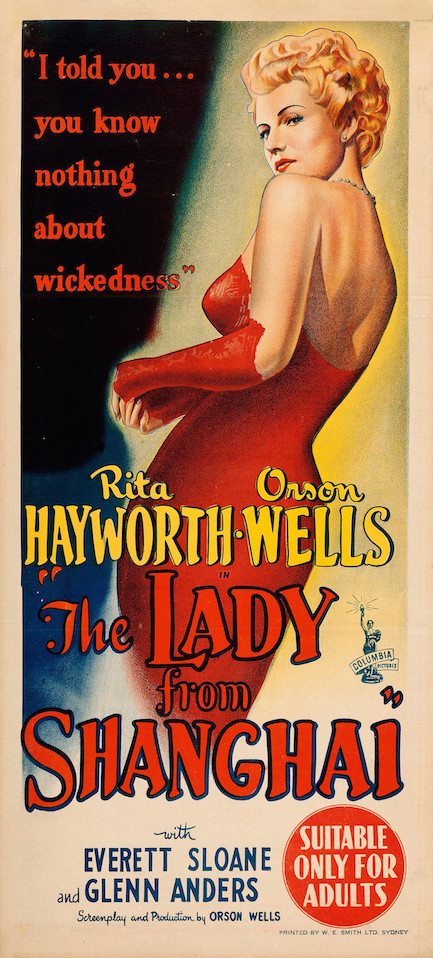
The film noir The Lady from Shanghai, starring Hollywood icons Rita Hayworth and Orson Welles, and directed by Welles, premiered in 1947 but reached Australia today in 1948, with this stunning promo poster having been distributed Down Under to help attract audiences. This film had amazing promos in many countries, some of which we'll show you later, and they all spelled Welles' last name correctly, which this one didn't. All the brilliant poster work around this movie is ironic, because Harry Cohn, who was the shot-caller at Columbia Pictures, hated it. He even shelved the flick for a year while he waited for what he deemed to be the best date to release it. When he finally did, what audiences saw was a radically altered version of Welles' original edit.
What did Cohn specifically hate about the film? Foremost there was its length, which was 155 minutes, and which Cohn ordered condensed, with the final running time coming to a mere 88 minutes. He also felt Hayworth didn't have enough close-ups, so he had those shot during extensive re-takes. Hayworth also didn't have a song, which was standard for film noir leading ladies, so Cohn had a number added and had Hayworth's voice dubbed. He hated the lighting, which he felt was a negative result of Welles choosing location work over controlled studio conditions. And he especially hated that Hayworth had agreed to chop off her auburn hair and dye it platinum. The list goes on but you get the point—clashing creative visions. Nothing new in Hollywood.
The Lady from Shanghai finds Welles playing a typical film noir schmo who falls in love with a femme fatale and is drawn into a murder plot. Other familiar film noir tropes include a trip to Mexico (not in the original novel by Sherwood King) and a tense court showdown. But what's decidedly uncommon here is Welles' visual mastery of the cinematic form. His abilities there have been exhaustively discussed and are in no way overrated, but visuals are only part of the filmic equation. There's also narrative pace and story cohesion and emotional tone, and those are areas where the movie runs into a bit of trouble. Since Welles' cut was so much longer (and presumably better) than what has ever been seen by the public, many of those problems were probably introduced by clumsy third parties.
But we can only judge what we see. Since all that missing footage is thought to have been destroyed, it takes a major leap of faith to see a masterpiece in what Welles himself thought was a diced up travesty of his original vision. We don't understand how anyone can truly revere him, yet disregard his artistic opinion. But that's exactly what some contemporary film writers do. We recently read a review that discussed how well the visuals and music work together, but Welles hated the score, which he had no control over and which lacked the subtlety he wanted it to have. We suggest that a critic is trying way too hard when they lavish praise upon a director for something he didn't even do. Welles was a genius—agreement on that point is universal. But even geniuses are not so magical that their abilities can overcome the artistic myopia and careless scissors of studio heads.
The Lady from Shanghai received mixed reviews when released, and ultimately, those reviews strike us as fair. There's plenty here worth seeing, particularly the ravishing Hayworth and nice location work in Acapulco and Sausalito, and of course Welles makes shots like Steph Curry makes 3s. But even so, the final result is good but not great. Not a failure, but not a top notch film noir. Calling The Lady from Shanghai one of the best of the genre is just unfair to the many, many great noirs that were made. Still, if you're a noir fan you should see it. And we're confident you'll enjoy it like we did. On the other hand, if you've never watched a film noir and this happens to be first one you see, we can easily picture you giving a shrug and drifting away from the genre, never to return.
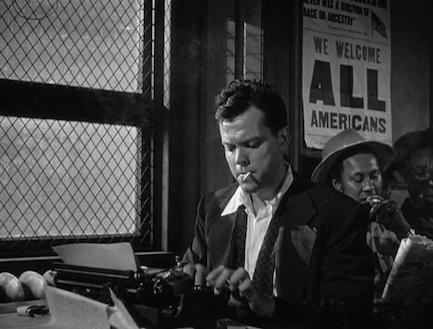
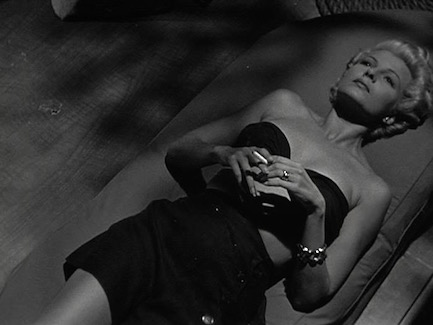
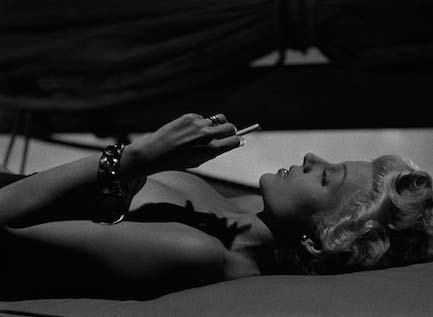
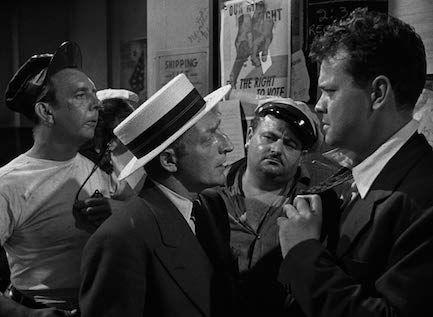



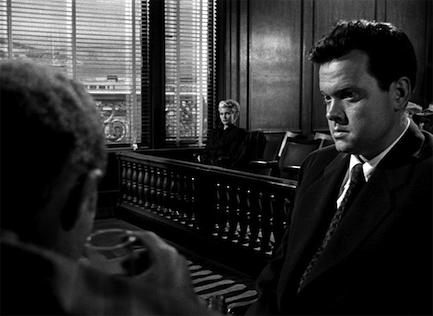
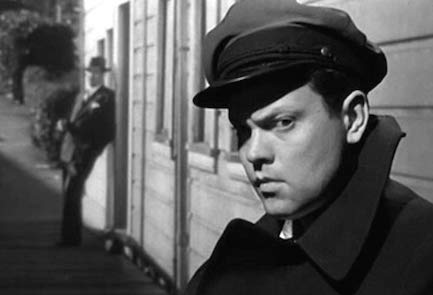

| Femmes Fatales | Musiquarium | Feb 28 2020 |

Sugar and spice and everything nice.

Above is shot of cinematic girl-next-door Jane Powell, who rose to fame in Hollywood musicals such as Holiday in Mexico, Seven Brides for Seven Brothers, and Royal Wedding. While Powell is fondly remembered for those and similar roles, she found it ridiculous that she played teenagers into her mid-twenties even though she had children of her own by that point. Under the studio system she had little choice, but later she did manage to expand her repertoire, co-starring in the Hedy Lamarr melodrama The Female Animal. Afterward she turned her attentions mainly to television, with guest slots on everything from Goodyear Theatre to Fantasy Island. She also had stage and singing careers, and scored a top 20 hit with 1956's “True Love.” The photo you see here was made to promote her 1957 musical The Girl Most Likely, and a shot from the same session appeared on the cover of the soundtrack album, which you see below. We don't generally do musicals here, but we will certainly check out her dramatic turn in The Female Animal. Meanwhile you may want to check out this rare photo we shared a couple of years ago.

| Vintage Pulp | Feb 23 2020 |

Lives and deaths converge at a river crossing in John D. MacDonald's iconic thriller.

Fawcett Publications kept illustrator Barye Phillips mighty busy with its Gold Medal line, and here his work is yet again, on the cover of John D. MacDonald's 1952 thriller The Damned. The creekside setting doesn't actually capture the mood of the book, but it's a very nice, ominously serene piece of art. Beyond the cover readers will encounter MacDonald wrestling with what we considered to be a very literary concept. An automobile ferry develops various issues, leaving a long line of cars stuck at a Mexican river crossing most of a day and all of a night. Except for the few people who had driven there together, none know each other, but on that desolate roadside they interact in life-changing ways, ranging from budding love to betrayal to abandonment to sudden death. With more than a dozen stories interwoven, none are truly resolved, but most characters end up pointed toward destinies that can be guessed. As we've mentioned before, the farther you go back into MacDonald's bibliography the less didactic he tends to be. The Damned is his fifth novel, and its freshness of concept speaks to a writer spreading his wings and reveling in the purity of creative flight. This is the MacDonald we think newcomers to his work will enjoy most.
| Vintage Pulp | Feb 1 2020 |

It happened four nights.
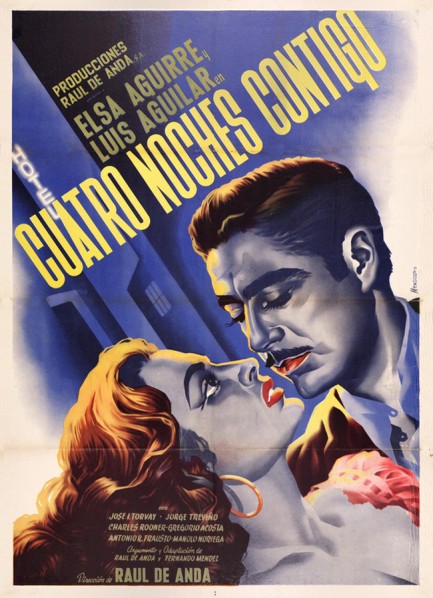
Cuatro noches contigo is not a pulp style movie, so we won't get into detail about it, except to say that it's a Mexican version of the iconic comedy It Happened One Night, with Luis Aguilar, the beautiful Elsa Aguirre, some musical numbers, a lot of cuteness, and one spanking. But we wanted to call attention to the film's art deco influenced poster. It was painted by Leopoldo Mendoza Andrade, who signed his work as Mendoza and was one of the artists who popularized this style in Mexican promo art during the 1950s. We haven't yet seen one of these art deco creations that isn't stunning. See what we mean here, here, here, and here. Cuatro noches contigo premiered in Mexico today in 1952, and if you understand Spanish and want to check it out, for now it's on YouTube at this link.
| Femmes Fatales | Dec 12 2019 |

Monteros gives a boost to Tahitian tourism.

The glowing figure you see above is Mexican actress Rosenda Monteros, who appeared in such films as The White Orchid and The Magnificent Seven, and is seen here in a production photo made for the 1962 movie Tiara Tahiti. This really is a beautiful image. Since the movie was actually was filmed mainly in Tahiti, rather than in, like, Long Beach, this shot was doubtless made on the island. A cinema is the closest most people will ever get to that legendary Pacific paradise, but we bet Monteros made plenty of people want to go. We have another nice shot of her below.

| Modern Pulp | Nov 11 2019 |

What's a crime? Being unable to identify the artist.

Has the Mexican crime art revival passed? Maybe, but not on Pulp Intl. We've talked about this niche quite a bit, and today we're veering back in that direction to share this piece entitled “Crimen Perfecto,” painted during the early 1980s by someone who signed as Yuno. Yuno who? We dunno. Do you? You do? Let us know. Actually, we don't expect you to know, because these artists were rarely properly credited, nor properly compensated, we suspect.
For that reason they never could have expected interest in their work to rekindle, but it did, and for a while auctions in these were pretty active, both online and in brick-and-mortar. The technical execution on display isn't what you'd usually find in classic paperback art, but as critic Ken Johnson wrote in the New York Times in 2015, “The value of [Mexican crime] paintings isn’t to be found in their aesthetic sophistication or refinement. This is truly art for the masses, as kitschy as it is amusing.”
He forgot to mention horrifying and violent. A smart person once said that violent societies have violent amusements, and Mexico, like the U.S., has certain strains in its culture that persistently glorify mayhem. Art such as this gives you a glimpse of that, put to pasteboard via brush and paint. While the artists remain mostly unknown, what they produced resonates all these decades later. See more wild Mexican crime art here, here, here, and here.
| Vintage Pulp | Oct 12 2019 |

Why did the girl cross the river? For a chance at a better future.
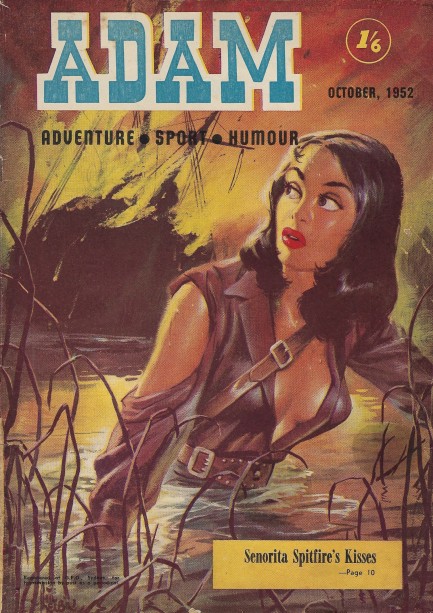
This issue of Adam published this month in 1952 is the second oldest issue of the magazine we've scanned and uploaded, and we gotta tell you, this thing was fragile as butterfly wings. But we got it done, and the magazine survived. The beautiful cover painting is signed by Phil Belbin, and it illustrates longtime pulp western writer Bob Obets' tale “Señorita Spitfire's Kisses”—let's just pause and enjoy that title, shall we? There's all sorts of promise in a title like that. It's simultaneously evocative and ridiculous, which often bodes well. The story is an adventure set on the Texas/Mexico border just after the U.S. Civil War. Basically, it's about a Mexican woman named Carlotta O'Farel y Cavazos who enlists the aid of a mercenary named Ricardo Ruby to cross the Rio Grande into Texas in search of a cache of money buried there. She plans to use it to buy guns for Mexican soldiers, while the captain is thinking maybe to have it for himself.
Here's a fun exchange (Ricardo refuses to call Carlotta by name at first, preferring to make up nicknames):
Ricardo: “Look, Flame of the River, just tell me where that eighty thousand is—and how come you know about it.”
Carlotta: “I was tellin' you, brains-of-a-donkey, the money is in this place call Corpus Christi, where my brother wait for the sheep to take this money to Cuba.”
Her insult really amused us for some reason. “Sheep,” by the way, is “ship” pronounced with an accent. Genre authors sometimes use phonetic spellings to portray accents, but it can cross the line into making the speaker sound stupid. It's something to avoid. After all, the presence of an accent means the speaker knows at least two languages, not just one, like most Americans. The most elegant authors, like Cormac McCarthy, write accents without alternate spellings. Obets opts for the clumsy method, having Carlotta say things like “sometheeng,” and “fineesh,” but he's a good writer anyway. In fact the story is good enough that we checked his bibliography. He's written at least two novels—1958's Blood Moon Range and 1965's Rails to the Rio. We may pick one up. In the meantime, we have a few scans, which include photos of Marie Windsor and Mari Blanchard. More Adam to come.
Her insult really amused us for some reason. “Sheep,” by the way, is “ship” pronounced with an accent. Genre authors sometimes use phonetic spellings to portray accents, but it can cross the line into making the speaker sound stupid. It's something to avoid. After all, the presence of an accent means the speaker knows at least two languages, not just one, like most Americans. The most elegant authors, like Cormac McCarthy, write accents without alternate spellings. Obets opts for the clumsy method, having Carlotta say things like “sometheeng,” and “fineesh,” but he's a good writer anyway. In fact the story is good enough that we checked his bibliography. He's written at least two novels—1958's Blood Moon Range and 1965's Rails to the Rio. We may pick one up. In the meantime, we have a few scans, which include photos of Marie Windsor and Mari Blanchard. More Adam to come.
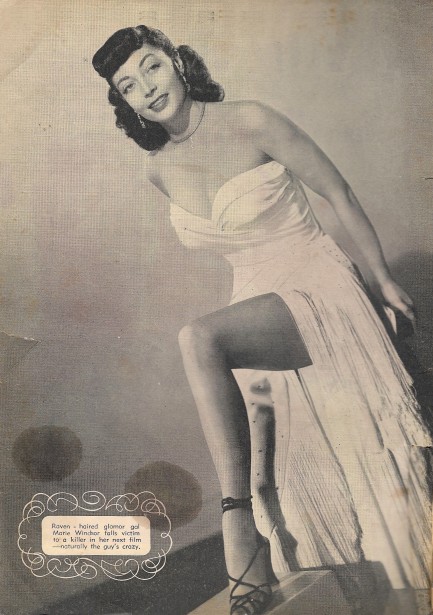
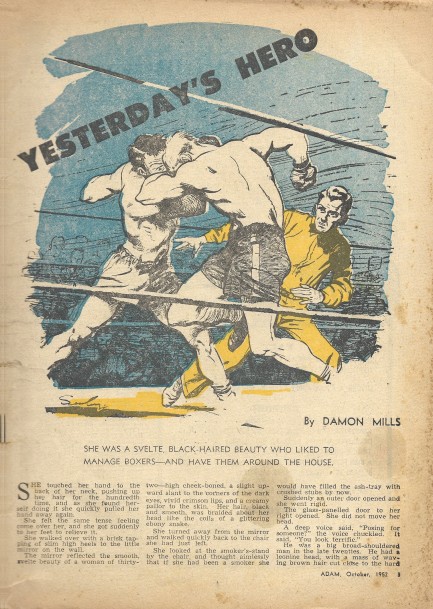
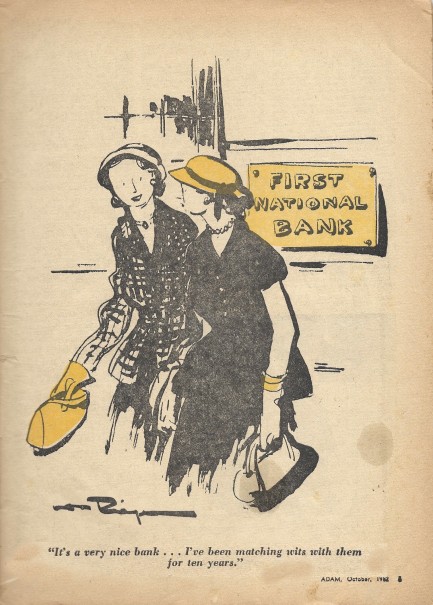
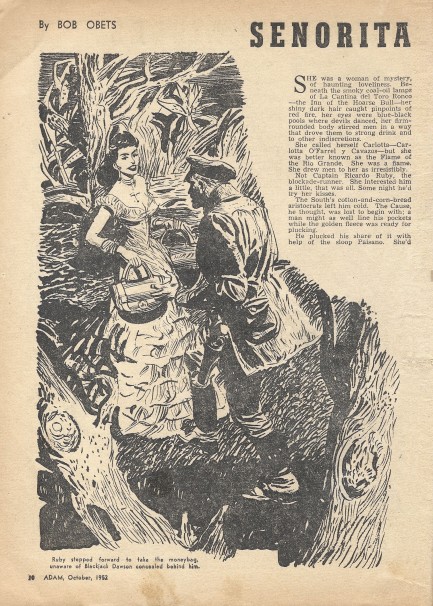
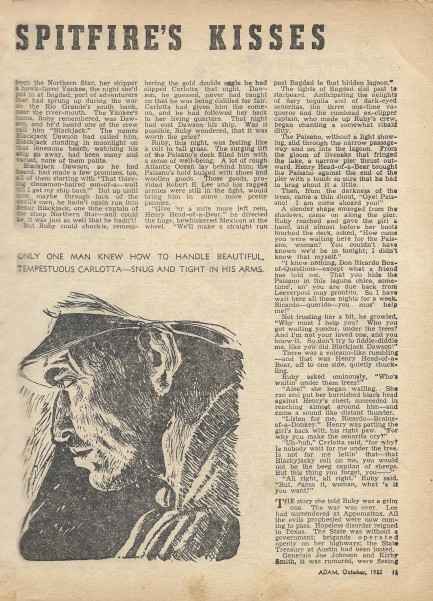
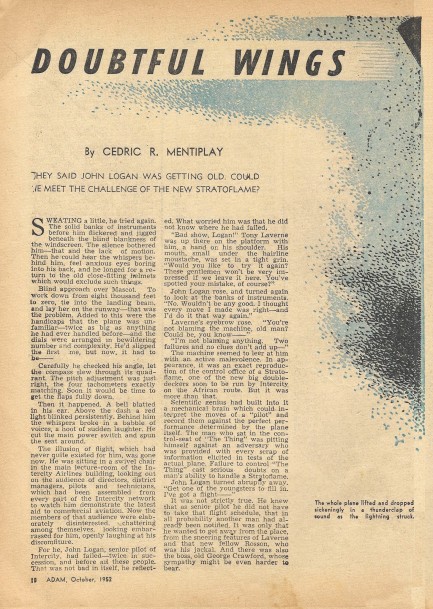

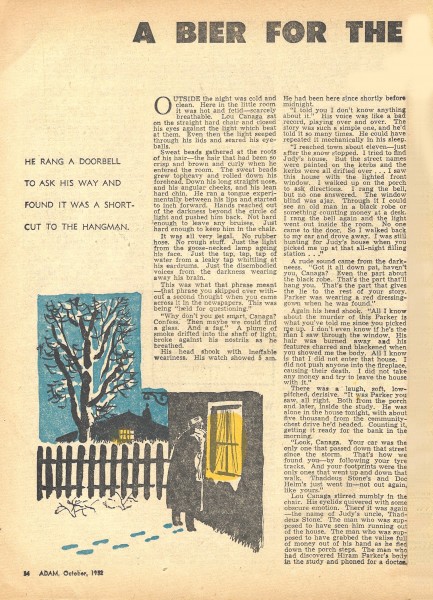
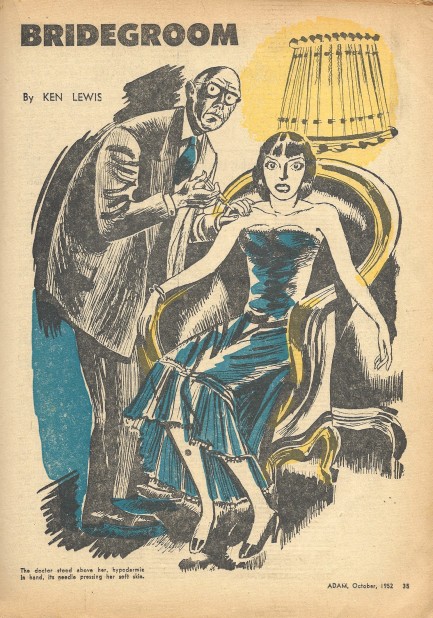
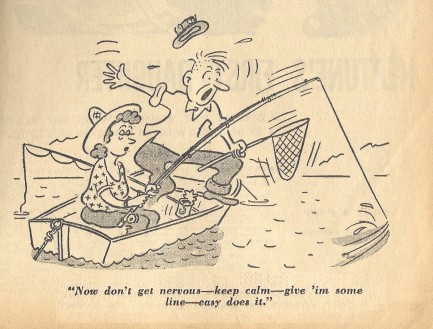
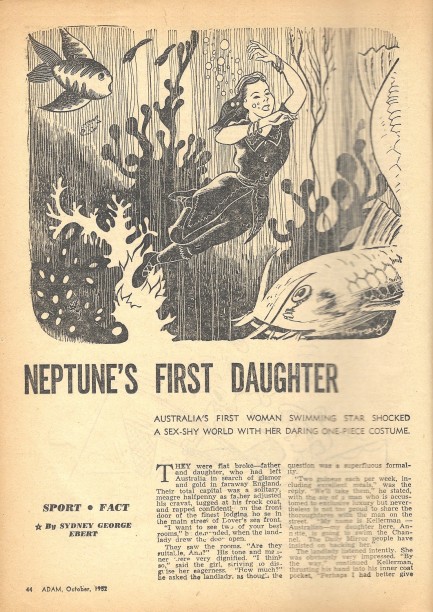
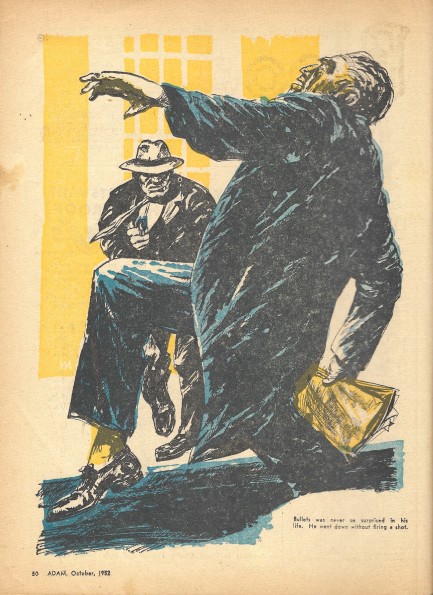
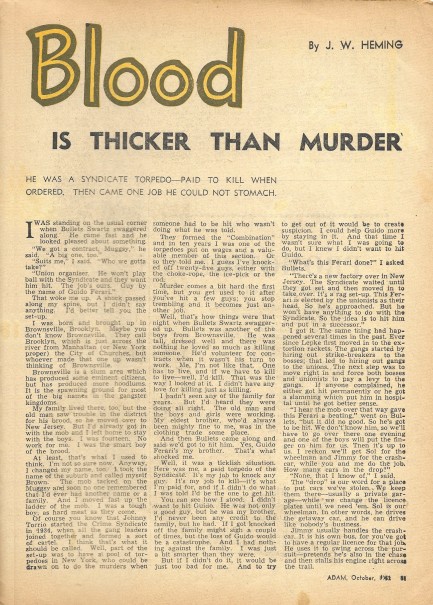
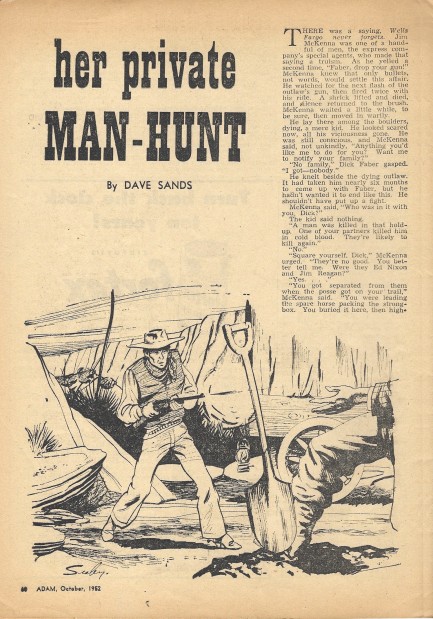
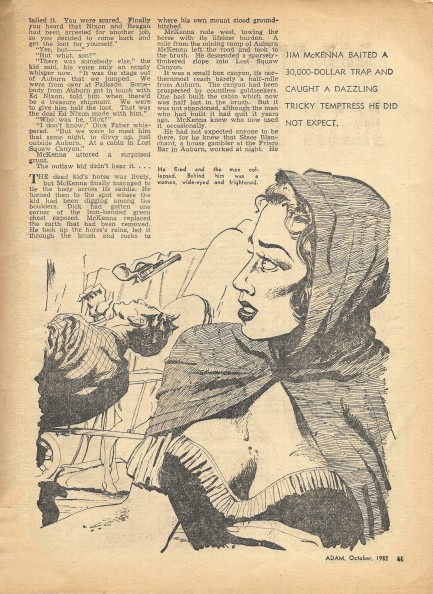
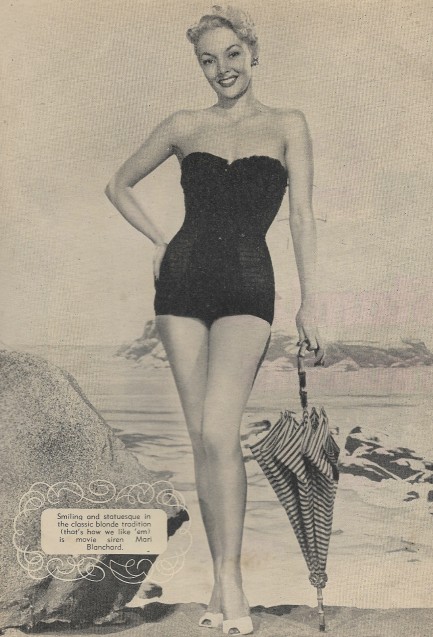

 |
 |




































































